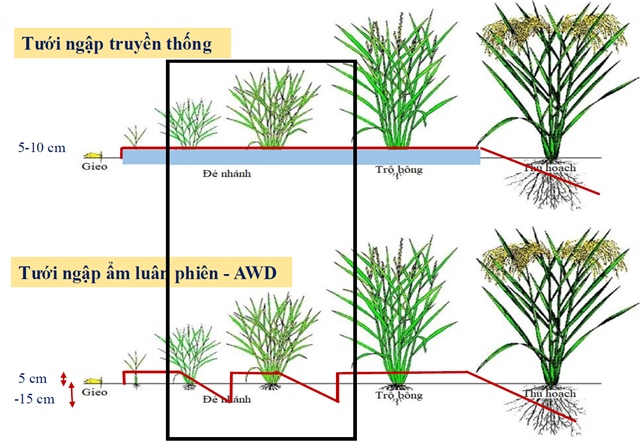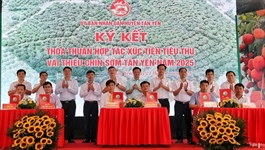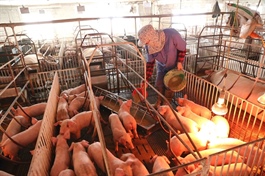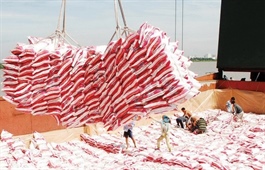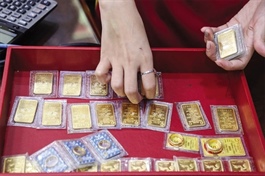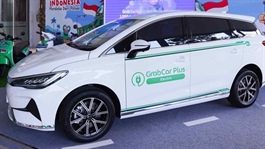Alternate wetting and drying irrigation technology aids climate-resilient rice farming
Alternate wetting and drying irrigation technology aids climate-resilient rice farming
Assoc.Prof.Dr. Nguyen Dinh Tho, president of the Institute of Strategy and Policy on Agriculture and Environment, and Jun Okita, CEO of Green Carbon, spoke to VIR's Song Oanh about the role of alternate wetting and drying (AWD) irrigation technology in rice cultivation.
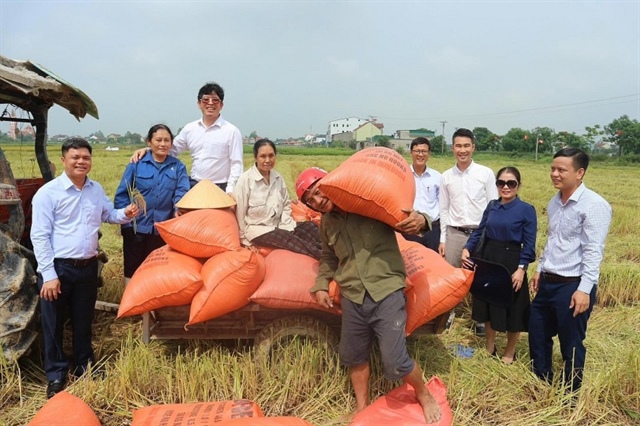
Alternate wetting and drying is a climate-resilient rice farming solution and pathway to carbon credit markets |
When applied to rice farming, AWD promotes efficient water use and significantly reduces methane emissions from paddy fields. Alternating wet and dry soil conditions foster aerobic processes and suppress the activity of anaerobic microorganisms, the main contributors to greenhouse gas emissions in flooded fields.
Emission reductions are achieved through precise cultivation techniques and strict monitoring procedures, from controlling water levels to determining optimal irrigation timing. This model lowers emissions and allows for measurable outcomes that can be converted into carbon credits. It incentivises farmers to maintain and expand the model while building a bridge between agricultural production and sustainable markets committed to emission reduction.
Provinces like Nghe An can progressively develop emission reduction verification systems based on the AWD model, laying the foundation for carbon credit transactions in agriculture. To realise this, technical and financial support are essential from international organisations, green agriculture initiatives, and climate funds. Once monitoring systems are in place, reduced methane emissions can be integrated into voluntary carbon credit platforms.
Since traditional rice farming is among the largest methane emitters in rural areas, transitioning to AWD, with relatively simple technical adjustments, has the potential to generate large volumes of carbon credits. The mechanism offers dual benefits: additional income for farmers, and progress towards national emission reduction goals.
The success of AWD depends on farmers’ access to information and willingness to adopt the method. Rural communities need technical knowledge, training on water management aligned with rice growth stages, and guidance on accurate water-level measurement. The use of technologies such as sensors, online data platforms, and early warning systems will enable timely adjustments in irrigation practices, conserving water while maintaining yields. At the same time, rice quality is preserved, generating internationally standardised carbon credits.
Compared to the energy or industrial sectors, agriculture is often underestimated in its emission reduction potential due to challenges in measurement and verification. However, AWD, combined with digital technologies like blockchain, satellites, and AI, is gradually breaking down these barriers. With its controlled inputs and stable outputs, the AWD model brings transparency to the entire farming process, connecting farmers with the global carbon finance ecosystem.
|
For rice farmers, participating in carbon credit programmes through AWD improves livelihoods and reduces costs related to irrigation, fertiliser, and pest management. It also opens up access to premium, eco-friendly rice markets. Financial institutions, agribusinesses, and support funds can act as intermediaries linking farmers with carbon credit buyers, thereby fostering a sustainable and climate-resilient agricultural value chain.
Practical experience from the 2024 summer-autumn crop in Nghe An demonstrates the model’s potential. On 11,152.5 hectares of AWD rice, total emission reductions reached 71,088.3 tonnes of CO₂e, significantly higher than in the spring crop. Of this, direct seeding areas covered 9,277.9 ha with a reduction of 6.3 tonnes CO₂e per ha (58,487 tonnes in total), while transplanted areas covered 1,874.6 ha with a reduction of 6.7 tonnes CO₂e per ha (12,601.3 tonnes). Every hectare converted to AWD marks clear progress towards low-emission agriculture.
Nghe An possesses natural conditions and an irrigation infrastructure well-suited for wide-scale AWD implementation. The climate, water availability, and flat terrain in districts like Yen Thanh, Dien Chau, and Hung Nguyen provide favourable conditions for alternating irrigation, enabling effective water-level control, reducing loss, and enhancing plant nutrient absorption.
In participating communes, farmers have received AWD irrigation training, learning to determine irrigation timing through field observation or water-level measurement tools. Many households report water savings of 30-40 per cent, stable yields, and growing motivation for long-term adoption. Compared to traditional continuous flooding, AWD has shown greater stability, reduced crop lodging, and significantly lowered methane emissions due to intermittent drying interrupting anaerobic decomposition.
Data indicates that AWD reduces CO₂e emissions by more than half compared to conventional methods, specifically 60.11 per cent for direct seeding and 52.94 per cent for transplanting. These results provide a solid basis for calculating carbon credits, with each ton of reduced CO₂e equivalent to one tradable, accumulable, or transferable credit. The success points to the model’s scalability in other delta or midland provinces with similar irrigation systems.
Based on these outcomes, the AWD model in Nghe An can be considered a solid foundation for developing carbon credit policies in agriculture. Establishing a robust measurement, reporting, and verification system is a prerequisite for ensuring transparency and effectiveness in carbon credit transactions. This is a strategic step towards integrating agriculture into the national emission reduction agenda and transitioning to a low-carbon economy.
- 15:48 11/06/2025


